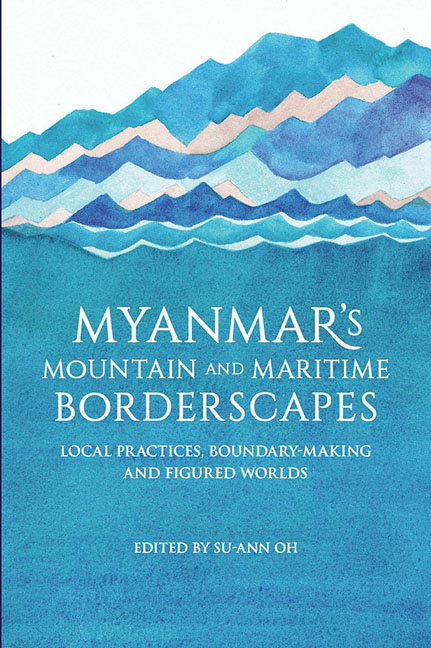Book contents
- Frontmatter
- Contents
- List of Tables
- List of Figures
- Acknowledgements
- Notes on Language, Terminology and Geographical Names
- Contributors
- Abbreviations
- 1 Introduction
- I Overview of Myanmar's Mountain and Maritime Borderscapes
- 2 Electoral Sovereignty in Myanmar's Borderlands
- 3 The Maritime Frontier of Myanmar: Challenges in the Early 21st Century
- II Territorial Claims and Imagined Boundaries
- III Social Organization and Border Economies
- IV Mobile Practices and Moving Borders
- V Identity Construction and the Politics of Belonging
- VI Institutionalized Identity and Border Practices
- Index
3 - The Maritime Frontier of Myanmar: Challenges in the Early 21st Century
from I - Overview of Myanmar's Mountain and Maritime Borderscapes
Published online by Cambridge University Press: 06 June 2017
- Frontmatter
- Contents
- List of Tables
- List of Figures
- Acknowledgements
- Notes on Language, Terminology and Geographical Names
- Contributors
- Abbreviations
- 1 Introduction
- I Overview of Myanmar's Mountain and Maritime Borderscapes
- 2 Electoral Sovereignty in Myanmar's Borderlands
- 3 The Maritime Frontier of Myanmar: Challenges in the Early 21st Century
- II Territorial Claims and Imagined Boundaries
- III Social Organization and Border Economies
- IV Mobile Practices and Moving Borders
- V Identity Construction and the Politics of Belonging
- VI Institutionalized Identity and Border Practices
- Index
Summary
Myanmar, geographically located at the junction of South, Southeast, and East Asia, shares common maritime boundaries with Bangladesh in the northeast of the Bay of Bengal, with Thailand and India in the Andaman Sea. From the mouth of the Naf River to Kawthaung (Bayint Naung Point), Myanmar has a 2,228-kilometre (1,385-mile) coastline. The coastline consists of three sections: the Rakhine coastline of 713 kilometres (443 miles), the Ayeyarwady Delta coastline of 437 kilometres (272 miles), and the Tanintharyi coastline of 1,078 kilometres (670 miles). On land, the coastline is shared by six administrative states or regions in Myanmar, namely, Rakhine State, Ayeyarwady Region, Yangon Region, Bago Region, Mon State and Tanintharyi Region. After the declaration of the Territorial Sea and Straight Baseline in 1968, Myanmar promulgated its Territorial Sea and Maritime Zones Law in 1977, prior to the conclusion of the 1982 United Nations Convention on the Law of the Sea (UNCLOS). Myanmar then signed the UNCLOS and ratified it on 21 May 1996, after which it came into effect on 20 June 1996. In accordance with Article 76 (paragraph 8) of the UNCLOS, on 16 December 2008, Myanmar submitted information on the limits of the continental shelf beyond 200 nautical miles from the baselines to the Commission on the Limits of the Continental Shelf. Myanmar has 29,043 square nautical miles of internal waters and 9,895 square nautical miles of territorial waters (please see Table 3.1 for more details). There are 852 big and small islands in Myanmar waters.
This chapter describes the challenges posed by domestic contenders and foreign entities on the Myanmar state's authority, management and control of the maritime frontier, highlighting the many actors involved in making and unmaking the frontier in Myanmar waters. In addition, it looks at the emerging politics of resource control between the central and local/regional governments, for the first time in Myanmar at least since 1962. Using two types of natural resources located in Myanmar waters as examples — fish stocks and hydrocarbon reserves — this chapter describes and analyses the way in which the exploitation of natural resources affects local and central politics, people's livelihoods and the forms of collusion between business and government.
- Type
- Chapter
- Information
- Myanmar's Mountain and Maritime BorderscapesLocal Practices, Boundary-Making and Figured Worlds, pp. 70 - 96Publisher: ISEAS–Yusof Ishak InstitutePrint publication year: 2016



